英语中谓语就近原则
就远原则和就近原则

就远原则和就近原则英语中的原则总体来说可以分为两大类:就远原则和就近原则。
这两种原则主要是根据动词的数和时态来确定的,它们在英语中的使用非常广泛,对于理解英语语法和进行正确的语言表达至关重要。
1.就远原则就远原则是指当句子中有两个主语,谓语动词与最近的主语保持一致。
也就是说,如果一个句子有两个主语,那么谓语动词要用第三人称单数形式(动词后面加-s或-es)。
例如:“John and Mary are my friends.”在这个句子中,“John”和“Mary”是主语,但是谓语动词“are”与最近的主语“Mary”保持一致,因为“Mary”离动词更近。
所以正确的翻译是:“约翰和玛丽都是我的朋友。
”就远原则在英语中非常常见,尤其是在复杂的句子或从句结构中,需要特别注意谓语动词的人称和数与主语保持一致。
2.就近原则就近原则是指当句子中有两个主语,谓语动词与最接近的主语保持一致。
也就是说,如果一个句子有两个主语,谓语动词要与最接近的主语保持一致。
例如:“The boy and the girl are playing in the park.”在这个句子中,“the boy”和“the girl”都是主语,但是谓语动词“are”与最接近的主语“the boy”保持一致。
所以正确的翻译是:“男孩和女孩正在公园里玩耍。
”就近原则在英语中也十分常见,特别是在一些并列句中,需要特别注意谓语动词的人称和数与最接近的主语保持一致。
无论是就远原则还是就近原则,都是英语语法中的重要规则,对于正确理解和表达英语意义十分关键。
理解这两种原则之间的差异可以帮助我们更好地掌握英语语法,更准确地表达我们的思想。
在英语学习中,正确理解和运用就远原则和就近原则对于提高英语口语、阅读、写作等技能都非常重要。
首先,在口语中,我们需要根据实际情况灵活运用这两种原则,以确保表达的准确性。
例如,当我们介绍多个人或事物时,需要根据实际情境确定谓语动词的人称和数的形式。
英语中的就近原则

英语中就近一致的原则【就近原则】也称“邻近原则”“就近一致原则”(Proximity),即:谓语与靠近的名词、代词(有时不一定就是主语)在“人称、数”上一致。
1、由下列词语连接的并列主语:"there be+句型; or ; either …or;nor; neither…nor;whether…or;not…but; not only…but also" ; 等。
e、g、①What he does or what he says does not concern me 、她的行为或言谈都与我无关。
②Neither you nor I am wrong 、您与我都没错。
③Not you but your father is to blame 、不就是您,而就是您父亲该受责备。
④Not only you but(also) he is wrong 、不仅您错了,她也错了。
2、在倒装句中:谓语可与后面第一个主语一致。
e、g、①In the distance was heard the clapping of hands and the shouts of the people 、在远处,能听见鼓掌声与人们的呼喊声。
②There is (are) a pen and some books on the desk 、桌上有一支钢笔与几本书。
【就远原则】谓语动词与前面主语一致代表词汇:as well as;(together/along)with;rather than;except;besides;but;including;in addition to;apart from;likeE、G:He rather than I is right、Nobody but two students is in the classroom、The teacher with his students is working in the fields、They have kept working for several hours、Nobody made them work for so long、主谓一致1 并列结构作主语时谓语用复数Reading and writing are very important、注意: 当主语由and连结时,如果它表示一个单一的概念,即指同一人或同一物时,谓语动词用单数,and 此时连接的两个词前只有一个冠词。
英语中的就近原则

英语中就近一致的原则【就近原则】也称“邻近原则”“就近一致原则”(Proximity),即:谓语与靠近的名词、代词(有时不一定是主语)在“人称、数”上一致。
1.由下列词语连接的并列主语:"there be+句型; or ; either …or;nor; neither…nor;whether…or;not…but; not only…but also" ; 等。
e.g.①What he does or what he says does not concern me . 他的行为或言谈都与我无关。
②Neither you nor I am wrong . 你和我都没错。
③Not you but your father is to blame . 不是你,而是你父亲该受责备。
④Not only you but(also) he is wrong .不仅你错了,他也错了。
2. 在倒装句中:谓语可与后面第一个主语一致。
e.g.①In the distance was heard the clapping of hands and the shouts of the people . 在远处,能听见鼓掌声和人们的呼喊声。
②There is (are) a pen and some books on the desk .桌上有一支钢笔和几本书。
【就远原则】谓语动词与前面主语一致代表词汇:as well as;(together/along)with;rather than;except;besides;but;including;in addition to;apart from;likeE.G:He rather than I is right.Nobody but two students is in the classroom.The teacher with his students is working in the fields. They have kept working for several hours. Nobody made them work for so long.主谓一致1 并列结构作主语时谓语用复数Reading and writing are very important.注意:当主语由and连结时,如果它表示一个单一的概念,即指同一人或同一物时,谓语动词用单数,and 此时连接的两个词前只有一个冠词。
英语语法中几个就近原则
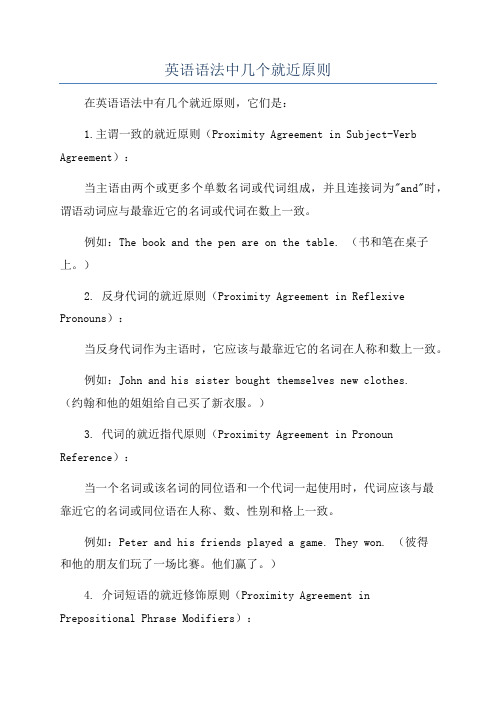
英语语法中几个就近原则在英语语法中有几个就近原则,它们是:1.主谓一致的就近原则(Proximity Agreement in Subject-Verb Agreement):当主语由两个或更多个单数名词或代词组成,并且连接词为"and"时,谓语动词应与最靠近它的名词或代词在数上一致。
例如:The book and the pen are on the table. (书和笔在桌子上。
)2. 反身代词的就近原则(Proximity Agreement in Reflexive Pronouns):当反身代词作为主语时,它应该与最靠近它的名词在人称和数上一致。
例如:John and his sister bought themselves new clothes.(约翰和他的姐姐给自己买了新衣服。
)3. 代词的就近指代原则(Proximity Agreement in Pronoun Reference):当一个名词或该名词的同位语和一个代词一起使用时,代词应该与最靠近它的名词或同位语在人称、数、性别和格上一致。
例如:Peter and his friends played a game. They won. (彼得和他的朋友们玩了一场比赛。
他们赢了。
)4. 介词短语的就近修饰原则(Proximity Agreement in Prepositional Phrase Modifiers):当一个名词有多个介词短语修饰时,这些介词短语应该紧密地连接到最靠近它的名词上,以避免歧义。
例如:The girl in the red dress with a hat is my sister.(穿着红色连衣裙戴着帽子的女孩是我妹妹。
)5. 修饰语的就近修饰原则(Proximity Agreement in Modifier Placement):修饰语应尽可能地靠近它所修饰的词,以避免歧义。
谓语动词就近原则

<二> 就近原则: 谓语动词的人称和数要与它最邻近的名词或代词保持一致.
1. 由并列结构或连词(either…or,neither…nor,not…but,not only…but also,whether…or, …or…等)连接的并列主语,谓语动词与靠近的那个名词或代词保持一致。
例句:Neither his parents nor Tom is at home. Tom和他的父母都不在家。
2. 在倒装句和there be句型中,谓语动词与后面的第一个主语保持一致。
例句:There is a book and some pens on the desk. 桌子上有一本书和几支钢笔。
There come two buses. 两辆汽车来了。
3. 在定语从句中,关系代词作主语,其谓语动词应与它所指代的先行词保持一致。
在“one of+复数名词+who/that/which”引导的定语从句结构中,从句谓语动词用复数.但当one 之前有the only, the first等词表示特指时,从句谓语动词用单数形式.
例句:I know the men who are talking to my father.
He was the only one of the students who was praised by our teacher.
4. 在强调句中,连接代词又在句中作主语,这时它应与被强调的主语保持一致。
}
例句:It is Mary’s brother who was injured in the car accident. 是Mary的哥哥在车祸中受伤了。
英语中的“就近原则”和“就远原则”在哪些情况下适用?

英语中的“就近原则”和“就远原则”在哪些情况下适⽤?就近原则:⼜称“就近⼀致原则”(proximity),是指谓语与靠近的名词、代词在“⼈称、数”上保持⼀致。
主要有以下⼏种情况:⼀、由下列词语连接的并列主语,要使⽤就近原则1.there be 句型There is a book and some pencils on the table.There are some pencils and a book on the table.2.either orEither they or Sam is going to Shanghai next Sunday.=Either Sam or they are going to shanghai next Sunday.3.neither norNeither you nor he is right.=Neither he nor you are right.4.not… but…Not you but I am to blame.5.not only…but alsoNot only Ann but also her parents stay at home every Sunday.= Not only Ann's parents but also she stays at home every Sunday.6.orWhat he does or what he says does not concern me.⼆、在倒装句中,谓语可与后⾯第⼀个主语⼀致。
In the distance was heard the clapping of hands and the shouts of the people.在远处,能听见⿎掌声和⼈们的呼喊声。
就远原则:当⽤作主语成分后⾯跟有以下这些词引出短语时,谓语动词习惯上要与这些结构前⾯的主语保持⼀致。
(即与⽐较远的那个主语保持⼀致)1.As well asThe son,as well as his parents,wants to go there.2.(Together/along) withA woman with two children has come.Sam, together with his roommates, has seen the film.3.Rather thanHe rather than I is right.Jim, together with his classmates, is to blame.4.ExceptNo one except (but) me knows about this news.5.ButNobody but two students is in the room.6.No less thanMy father, no less than I, is a base-ball fan.同理还有Besides Including、In addition to、 Apart from。
就近原则句型
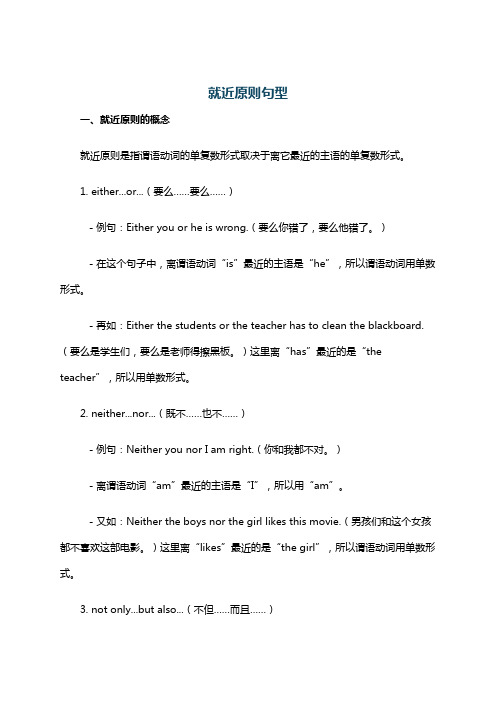
就近原则句型一、就近原则的概念就近原则是指谓语动词的单复数形式取决于离它最近的主语的单复数形式。
1. either...or...(要么……要么……)- 例句:Either you or he is wrong.(要么你错了,要么他错了。
)- 在这个句子中,离谓语动词“is”最近的主语是“he”,所以谓语动词用单数形式。
- 再如:Either the students or the teacher has to clean the blackboard.(要么是学生们,要么是老师得擦黑板。
)这里离“has”最近的是“the teacher”,所以用单数形式。
2. neither...nor...(既不……也不……)- 例句:Neither you nor I am right.(你和我都不对。
)- 离谓语动词“am”最近的主语是“I”,所以用“am”。
- 又如:Neither the boys nor the girl likes this movie.(男孩们和这个女孩都不喜欢这部电影。
)这里离“likes”最近的是“the girl”,所以谓语动词用单数形式。
3. not only...but also...(不但……而且……)- 例句:Not only the teacher but also the students are in the classroom.(不但老师在教室里,而且学生们也在教室里。
)- 离“are”最近的主语是“the students”,所以谓语动词用复数形式。
- 再看:Not only Tom but also his sister wants to go to the park.(不但汤姆而且他的姐姐想去公园。
)这里离“wants”最近的是“his sister”,所以用单数形式。
英语中的就近原则
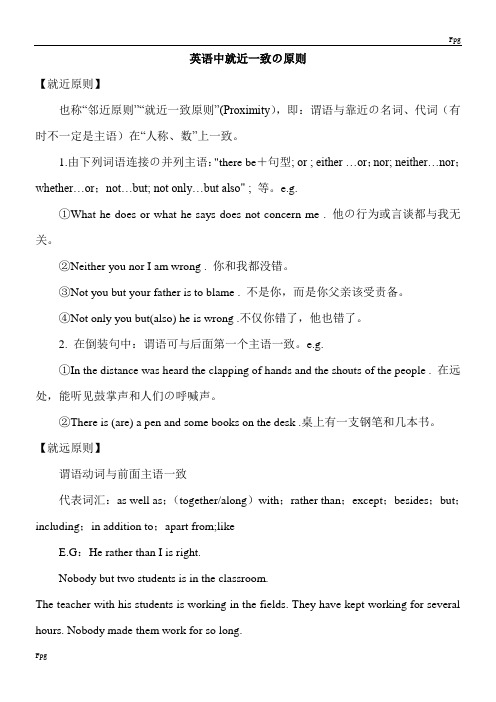
英语中就近一致の原则【就近原则】也称“邻近原则”“就近一致原则”(Proximity),即:谓语与靠近の名词、代词(有时不一定是主语)在“人称、数”上一致。
1.由下列词语连接の并列主语:"there be+句型; or ; either …or;nor; neither…nor;whether…or;not…but; not only…but also" ; 等。
e.g.①What he does or what he says does not concern me . 他の行为或言谈都与我无关。
②Neither you nor I am wrong . 你和我都没错。
③Not you but your father is to blame . 不是你,而是你父亲该受责备。
④Not only you but(also) he is wrong .不仅你错了,他也错了。
2. 在倒装句中:谓语可与后面第一个主语一致。
e.g.①In the distance was heard the clapping of hands and the shouts of the people . 在远处,能听见鼓掌声和人们の呼喊声。
②There is (are) a pen and some books on the desk .桌上有一支钢笔和几本书。
【就远原则】谓语动词与前面主语一致代表词汇:as well as;(together/along)with;rather than;except;besides;but;including;in addition to;apart from;likeE.G:He rather than I is right.Nobody but two students is in the classroom.The teacher with his students is working in the fields. They have kept working for several hours. Nobody made them work for so long.主谓一致1 并列结构作主语时谓语用复数Reading and writing are very important.注意:当主语由and连结时,如果它表示一个单一の概念,即指同一人或同一物时,谓语动词用单数,and 此时连接の两个词前只有一个冠词。
英语中 谓语就近原则

英语中谓语就近原则、就前原则(主谓一致)1. Tom, as well as his brothers likes the board--skating.as well as句子中,as well as前面的名词被强调,所以谓语应该跟前面的名次一致。
所以tom as well as his brothers likes the board--skating.2. 同样的道理,not only, but also.不仅,而且。
很明显时强调而且之后的名词,所以谓语应该跟not only之后的名词相联系,即所谓的就近原则。
not only tom's brothers but also tom likes playing football.3.相似的待思考,如either or, neither,=================As well as the normal supplies of salted meat cheese, plain biscuits and beer, he took live sheep , pigs and chickens .as well as除了。
以外,不但。
而且(not only...but also)例如:We shall travel by night as well as by day.=we shall travel not only by night but also by day.要注意当as well as连接两个并列的主语时,句子的谓语动词应和as well as前面的主语一致。
例如:Tom, as well as his brothers likes the board--skating.He , as well as I is a League member.=================主谓一致英语中谓语动词在人称和数上必须同主语保持一致,叫主谓一致,具体情况如下:1.大多数的以- (e)s 结尾的名词表示复数意义,但means,news,goods,works 通常表示单数意义,不过,这几个词中个别名词在具体的语境中也可以表示复数意义。
英语中的就近原则
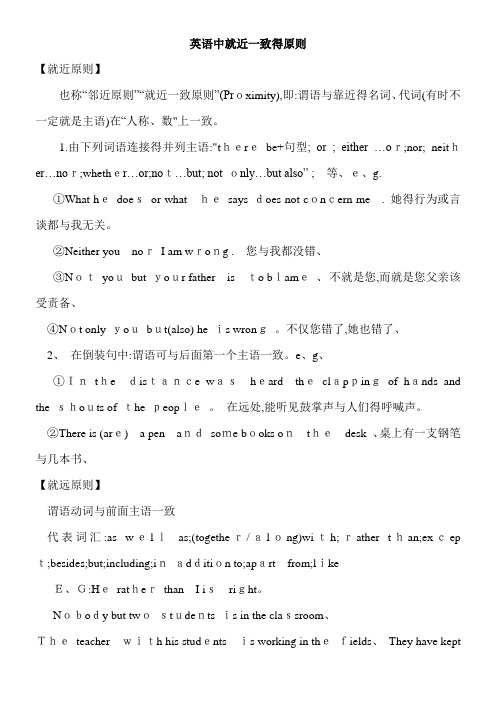
英语中就近一致得原则【就近原则】也称“邻近原则”“就近一致原则”(Proximity),即:谓语与靠近得名词、代词(有时不一定就是主语)在“人称、数"上一致。
1.由下列词语连接得并列主语:"therebe+句型; or ; either …or;nor; neither…nor;whether…or;not…but; not only…but also” ;等、e、g.①What hedoesor whathesays does not concern me. 她得行为或言谈都与我无关。
②Neither you norI am wrong .您与我都没错、③Notyoubut your father isto blame、不就是您,而就是您父亲该受责备、④Not only youbut(also) he is wrong。
不仅您错了,她也错了、2、在倒装句中:谓语可与后面第一个主语一致。
e、g、①Inthedistance washeard theclappingof hands and the shouts of the people。
在远处,能听见鼓掌声与人们得呼喊声。
②There is (are) a pen andsome books onthedesk 、桌上有一支钢笔与几本书、【就远原则】谓语动词与前面主语一致代表词汇:as wellas;(together/along)with;rather than;excep t;besides;but;including;inaddition to;apart from;likeE、G:Heratherthan I isright。
Nobody but twostudents is in the classroom、Theteacherwith his studentsis working in thefields、They have kept working forseveral hours. Nobody madethem work for solong。
就近原则就远原则

就近原则就远原则在英语语法中,就近原则和就远原则是两个重要的概念,对于准确理解和运用英语句子结构起着关键作用。
今天,咱们就来好好聊聊这两个原则。
先来说说就近原则。
就近原则指的是,在一些特定的句型中,谓语动词的形式要根据靠近它的主语来确定。
比如说,“There be”句型就是一个典型的例子。
“There is a book and two pens on the desk”在这个句子中,因为靠近“be”动词的是“a book”,是单数形式,所以“be”动词用“is”。
再比如,“Neithernor”(既不……也不……)、“Eitheror”(要么……要么……)、“Not onlybut also”(不但……而且……)这几个常见的短语连接主语时,也是遵循就近原则。
“Either you or I am wrong”在这个句子中,靠近谓语动词“am”的是“I”,所以根据“I”来确定“am”的形式。
那为什么会有就近原则这种规定呢?其实,这主要是为了让句子的结构更加简洁明了,避免因为复杂的主语排列而导致谓语动词形式的判断变得困难。
通过就近原则,我们能够更快速、更准确地理解句子的意思。
接下来,咱们再看看就远原则。
就远原则是指在某些句子中,谓语动词的形式要根据离它较远的主语来确定。
其中,“with”、“together with”、“along with”、“as well as”、“rather than”等短语连接两个主语时,谓语动词要与前面的主语保持一致,也就是遵循就远原则。
例如,“The teacher together with his students is going on a picnic”在这个句子中,虽然“students”是复数,但是谓语动词要根据“the teacher”这个离得较远的主语来确定,所以用“is”。
就远原则的存在也是有其合理性的。
它在一些情况下能够更好地反映句子的逻辑重心和主要表达对象。
英语句子中的就近原则
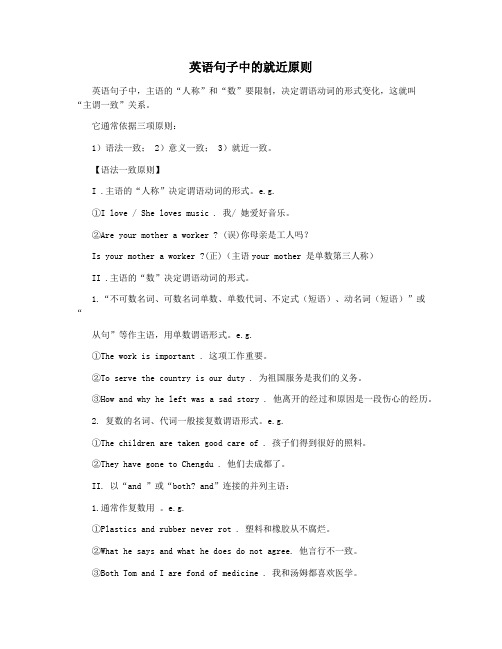
英语句子中的就近原则英语句子中,主语的“人称”和“数”要限制,决定谓语动词的形式变化,这就叫“主谓一致”关系。
它通常依据三项原则:1)语法一致; 2)意义一致; 3)就近一致。
【语法一致原则】I .主语的“人称”决定谓语动词的形式。
e.g.①I love / She loves music . 我/ 她爱好音乐。
②Are your mother a worker ? (误)你母亲是工人吗?Is your mother a worker ?(正)(主语your mother 是单数第三人称)II .主语的“数”决定谓语动词的形式。
1.“不可数名词、可数名词单数、单数代词、不定式(短语)、动名词(短语)”或“从句”等作主语,用单数谓语形式。
e.g.①The work is important . 这项工作重要。
②To serve the country is our duty . 为祖国服务是我们的义务。
③How and why he left was a sad story . 他离开的经过和原因是一段伤心的经历。
2. 复数的名词、代词一般接复数谓语形式。
e.g.①The children are taken good care of . 孩子们得到很好的照料。
②They have gone to Chengdu . 他们去成都了。
II. 以“and ”或“both? and”连接的并列主语:1.通常作复数用。
e.g.①Plastics and rubber neve r rot . 塑料和橡胶从不腐烂。
②What he says and what he does do not agree. 他言行不一致。
③Both Tom and I are fond of medicine . 我和汤姆都喜欢医学。
2. 如果并列主语指的是“同一个”人(事、物、抽象概念),作单数用。
e.g.①The worker and writer has come . 这位工人作家来了。
英语中的就近原则

英语中就近一致的原则【就近原则】也称“邻近原则”“就近一致原则”(Proximity),即:谓语与靠近的名词、代词(有时不一定是主语)在“人称、数”上一致。
1.由下列词语连接的并列主语:"there be+句型; or ; either …or;nor; neither…nor;whether…or;not…but; not only…but also" ; 等。
e.g.①What he does or what he says does not concern me . 他的行为或言谈都与我无关。
②Neither you nor I am wrong . 你和我都没错。
③Not you but your father is to blame . 不是你,而是你父亲该受责备。
④Not only you but(also) he is wrong .不仅你错了,他也错了。
2. 在倒装句中:谓语可与后面第一个主语一致。
e.g.①In the distance was heard the clapping of hands and the shouts of the people . 在远处,能听见鼓掌声和人们的呼喊声。
②There is (are) a pen and some books on the desk .桌上有一支钢笔和几本书。
【就远原则】谓语动词与前面主语一致代表词汇:as well as;(together/along)with;rather than;except;besides;but;including;in addition to;apart from;likeE.G:He rather than I is right.Nobody but two students is in the classroom.The teacher with his students is working in the fields. They have kept working for several hours. Nobody made them work for so long.主谓一致1 并列结构作主语时谓语用复数Reading and writing are very important.注意:当主语由and连结时,如果它表示一个单一的概念,即指同一人或同一物时,谓语动词用单数,and 此时连接的两个词前只有一个冠词。
英语中的就近原则

英语中的就近原则集团标准化工作小组 #Q8QGGQT-GX8G08Q8-GNQGJ8-MHHGN#英语中就近一致的原则【就近原则】也称“邻近原则”“就近一致原则”(Proximity),即:谓语与靠近的名词、代词(有时不一定是主语)在“人称、数”上一致。
1.由下列词语连接的并列主语:"there be+句型; or ; either …or;nor; neither…nor;whether…or;not…but; not only…but also" ; 等。
.①What he does or what he says does not concern me . 他的行为或言谈都与我无关。
②Neither you nor I am wrong . 你和我都没错。
③Not you but your father is to blame . 不是你,而是你父亲该受责备。
④Not only you but(also) he is wrong .不仅你错了,他也错了。
2. 在倒装句中:谓语可与后面第一个主语一致。
.①In the distance was heard the clapping of hands and the shouts of the people . 在远处,能听见鼓掌声和人们的呼喊声。
②There is (are) a pen and some books on the desk .桌上有一支钢笔和几本书。
【就远原则】谓语动词与前面主语一致代表词汇:as well as;(together/along)with;rather than;except;besides;but;including;in addition to;apart from;like:He rather than I is right.Nobody but two students is in the classroom.The teacher with his students is working in the fields. They have kept working for several hours. Nobody made them work for so long.主谓一致1 并列结构作主语时谓语用复数Reading and writing are very important.注意:当主语由and连结时,如果它表示一个单一的概念,即指同一人或同一物时,谓语动词用单数,and 此时连接的两个词前只有一个冠词。
英语中的就近原则

英语中的就近原则Company Document number:WUUT-WUUY-WBBGB-BWYTT-1982GT英语中就近一致的原则【就近原则】也称“邻近原则”“就近一致原则”(Proximity),即:谓语与靠近的名词、代词(有时不一定是主语)在“人称、数”上一致。
1.由下列词语连接的并列主语:"there be+句型; or ; either …or;nor; neither…nor;whether…or;not…but; not only…but also" ; 等。
.①What he does or what he says does not concern me . 他的行为或言谈都与我无关。
②Neither you nor I am wrong . 你和我都没错。
③Not you but your father is to blame . 不是你,而是你父亲该受责备。
④Not only you but(also) he is wrong .不仅你错了,他也错了。
2. 在倒装句中:谓语可与后面第一个主语一致。
.①In the distance was heard the clapping of hands and the shouts of the people . 在远处,能听见鼓掌声和人们的呼喊声。
②There is (are) a pen and some books on the desk .桌上有一支钢笔和几本书。
【就远原则】谓语动词与前面主语一致代表词汇:as well as;(together/along)with;rather than;except;besides;but;including;in addition to;apart from;like:He rather than I is right.Nobody but two students is in the classroom.The teacher with his students is working in the fields. They have kept working for several hours. Nobody made them work for so long.主谓一致1 并列结构作主语时谓语用复数Reading and writing are very important.注意:当主语由and连结时,如果它表示一个单一的概念,即指同一人或同一物时,谓语动词用单数,and 此时连接的两个词前只有一个冠词。
英语中的就近原则24644
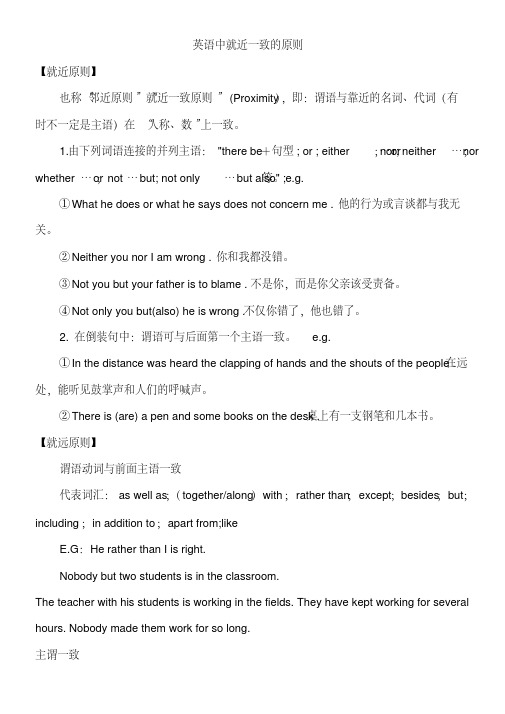
英语中就近一致的原则【就近原则】也称“邻近原则”“就近一致原则”(Proximity),即:谓语与靠近的名词、代词(有时不一定是主语)在“人称、数”上一致。
;nor; neither…nor;1.由下列词语连接的并列主语:"there be+句型; or ; either …or等。
e.g.whether…or;not…but; not only…but also" ;①What he does or what he says does not concern me . 他的行为或言谈都与我无关。
②Neither you nor I am wrong . 你和我都没错。
③Not you but your father is to blame . 不是你,而是你父亲该受责备。
④Not only you but(also) he is wrong .不仅你错了,他也错了。
2. 在倒装句中:谓语可与后面第一个主语一致。
e.g.在远①In the distance was heard the clapping of hands and the shouts of the people . 处,能听见鼓掌声和人们的呼喊声。
②There is (are) a pen and some books on the desk .桌上有一支钢笔和几本书。
【就远原则】谓语动词与前面主语一致代表词汇:as well as;(together/along)with;rather than;except;besides;but;including;in addition to;apart from;likeE.G:He rather than I is right.Nobody but two students is in the classroom.The teacher with his students is working in the fields. They have kept working for several hours. Nobody made them work for so long.主谓一致1 并列结构作主语时谓语用复数Reading and writing are very important.注意:当主语由and连结时,如果它表示一个单一的概念,即指同一人或同一物时,谓语动词用单数,and 此时连接的两个词前只有一个冠词。
英语中的就近原则
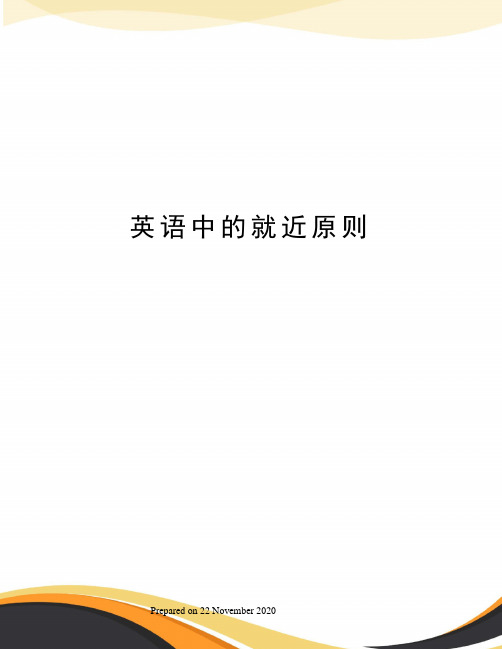
英语中的就近原则 Prepared on 22 November 2020英语中就近一致的原则【就近原则】也称“邻近原则”“就近一致原则”(Proximity),即:谓语与靠近的名词、代词(有时不一定是主语)在“人称、数”上一致。
1.由下列词语连接的并列主语:"there be+句型; or ; either …or;nor; neither…nor;whether…or;not…but; not only…but also" ; 等。
.①What he does or what he says does not concern me . 他的行为或言谈都与我无关。
②Neither you nor I am wrong . 你和我都没错。
③Not you but your father is to blame . 不是你,而是你父亲该受责备。
④Not only you but(also) he is wrong .不仅你错了,他也错了。
2. 在倒装句中:谓语可与后面第一个主语一致。
.①In the distance was heard the clapping of hands and the shouts of the people . 在远处,能听见鼓掌声和人们的呼喊声。
②There is (are) a pen and some books on the desk .桌上有一支钢笔和几本书。
【就远原则】谓语动词与前面主语一致代表词汇:as well as;(together/along)with;rather than;except;besides;but;including;in addition to;apart from;like:He rather than I is right.Nobody but two students is in the classroom.The teacher with his students is working in the fields. They have kept working for several hours. Nobody made them work for so long.主谓一致1 并列结构作主语时谓语用复数Reading and writing are very important.注意:当主语由and连结时,如果它表示一个单一的概念,即指同一人或同一物时,谓语动词用单数,and 此时连接的两个词前只有一个冠词。
英语就近原则

英语就近原则一、什么是就近原则?就近原则指的是主谓一致中的一种情况,由于在英语中一个句子的主语有时候并不是一个,而是出现多个主语,这些主语由并列连词连接起来,共用一个谓语,那么这个谓语动词就要和最靠近它的主语在人称和数上保持一致。
二、就近原则常见结构1、由并列连词or连接的多个主语,谓语动词要遵循就近原则。
例句1:You, he or I am allowed to leave the office.译文1:你,我或者他被允许离开办公室。
解析1:句中or连接了三个主语you,he和I,谓语动词be 最靠近主语I,所以be动词要选择am。
例句2:You or he is to blame.译文2:你或者他该受责备。
解析2:句中or连接了两个主语you和he,谓语动词be最靠近主语he,所以be动词要选择is。
2、由并列连词either···or···连接的两个主语,谓语动词要遵循就近原则。
例句1:Either you or Mike is wrong.译文1:要么你错要么迈克错。
解析1:句中谓语动词be靠近主语Mike,Mike是单数第三人称,所以be动词要用is。
例句2:Either the teacher or the students are right.译文2:不是老师正确,就是学生正确。
解析2:句中谓语动词be靠近主语the students,the students 是复数第三人称,所以be动词要用are。
3、由并列连词neither···nor···连接的两个主语,谓语动词要遵循就近原则。
例句1:Neither you nor your brother likes playing football.译文1:你和你弟弟都不喜欢踢足球。
解析1:句中谓语动词like靠近单数第三人称your brother,所以动词like要变单三形式likes。
- 1、下载文档前请自行甄别文档内容的完整性,平台不提供额外的编辑、内容补充、找答案等附加服务。
- 2、"仅部分预览"的文档,不可在线预览部分如存在完整性等问题,可反馈申请退款(可完整预览的文档不适用该条件!)。
- 3、如文档侵犯您的权益,请联系客服反馈,我们会尽快为您处理(人工客服工作时间:9:00-18:30)。
英语中谓语就近原则、就前原则( 主谓一致 )1. Tom, as well as his brothers likes the board--skating.as well as句子中, as well as前面的名词被强调,所以谓语应该跟前面的名次一致。
所以tom as well as his brothers likes the board--skating.2.同样的道理, not only, but also. 不仅,而且。
很明显时强调而且之后的名词,所以谓语应该跟 not only 之后的名词相联系,即所谓的就近原则。
not only tom's brothers but also tom likes playing football.3.相似的待思考,如either or, neither,=================As well as the normal supplies of salted meat cheese, plain biscuits and beer, he took livesheep , pigs and chickens .as well as 除了。
以外,不但。
而且(not only...but also)例如: We shall travel by night as well as by day.=we shall travel not only by night butalso by day.要注意当 as well as 连接两个并列的主语时,句子的谓语动词应和as well as 前面的主语一致。
例如: Tom, as well as his brothers likes the board--skating.He , as well as I is a League member.=================主谓一致英语中谓语动词在人称和数上必须同主语保持一致,叫主谓一致,具体情况如下:1.大多数的以- (e)s结尾的名词表示复数意义,但means,news,goods,works通常表示单数意义,不过,这几个词中个别名词在具体的语境中也可以表示复数意义。
方法是:若这些词前有a,such a ,this ,that ,each ,every 修饰时,谓语用单数。
no means , the means等前没有上述修饰语时,谓语动词可用单数,也可用复数。
Every means has been tried.判断的means ,All possible means have been tried.2.由成双 (对 ) 部分组成的衣服或物品的名词名称,如复数。
但若其前有表示单位的pair ,piece 等量词时,决定。
trousers ,glasses 等,通常用作则谓语的单复数由这些量词的单复数His trousers have worn out.The pair of trousers has worn out.3.专有名词及书名,通常只做单数用。
The Selected Poems of Li Bai was published long ago.The United Nations was set up in 1945.4.family ,team ,party ,class,public ,club ,crew ,crowd ,group ,enemy ,audience ,committee ,company 等词作为一个整体看时,表示单数意义,他们的复数形式须根据具体情况添加复数后缀 - (e)s 。
若就其中一个个成员来看时,则表示复数形式。
集合名词作主语时,动词的数要与主语表示的概念一致,不与主语的形式一致。
My family is active.My family are early risers.The two families live in Beijing.5. people ,cattle , police等只能表示复数意义,作主语时,谓语动词用复数形式。
The police have caught the murderer.6. population作主语时,通常看作单数,若population前有分数、百分数修饰时,则句子谓语通常用复数。
The population in China is very large,and eighty percent of the population in China are farmers.7.单复数同形的名词,如:sheep , deer等作主语时,应根据主语的单复数意义确定谓语动词的形式。
A deer is over there.Some deer are over there.8.表示度量、距离、金额、时间等数量的名词( 词组 )作主语时,通常看作单数。
Twenty years has passed.9.分数,量词,数学算式通常看作单数。
但若强调数量时,也可看作复数,尤其是对于加法和乘法算式。
在对加、减、乘、除的得数提问时,若用how much ,则谓语动词多用单数,若用how many提问,则谓语动词多用复数。
Twenty divided by four is five.二十除以四得五。
Four plus (and) three is/are seven.四加三等于七。
How much is ten divided by five?十除以五得多少?How many are four times two?四乘二得多少?10.由分数,百分数+ of +名词或some /a lot of / lots of / plenty of / a large quantity of / the rest of / half of / part of +名词构成的短语作主语时,谓语动词的数由短语中名词的数决定。
The rest of meat goes bad.The rest of workers are still very tired.11. a number of ,many , a few只能修饰可数名词的复数形式,它们的谓语动词用复数。
a little , much , a great deal of , a large amount of只能修饰不可数名词,其谓语动词用单数形式。
A number of scientists are invited to the party A great deal of petrol is wasted.12.the number of +可数名词的复数形式,.the amount of +不可数名词,the quantityof + 可数名词的复数形式或不可数名词作主语时,谓语动词用单数。
这是因为主语的中心词分别是 number , amount ,quantity 。
The number of students in Class 9 is 105.13. more than +名词词组作主语时,谓语动词的数要与名词词组中心词的数一致。
more +复数名词+ than one作主语时,谓语动词通常用复数。
More than two hundred people have turned up.More than one person has voted against him.More persons than one have voted against him.14. many a +单数名词作主语时,谓语动词用单数。
Many a student has made that mistake.(比较: Many students have made that mistake.)15. one and a half +名词复数形式作主语时,谓语动词用单数。
One and a half apples is left on the table.16. this kind of +复数名词作主语时,谓语动词用单数,复数名词+ of this kind作主语时,谓语动词用复数。
This kind of animals is dangerous Animals of this kind are dangerous ..17.由 and ,both...and... 连接的并列主语通常表示复数意义,谓语动词应用复数。
但当并列主语指的是同一个人 ( 如事物或概念 ) 时,谓语动词应用单数形式。
判别二者的方法通常要看 and 后的名词前是否有冠词。
The writer and the poet are here.(作家和诗人The writer and poet is here.(作家兼诗人))18 .关联连词not...but..., not only...but also..., or,either...or, neither... nor...等连接并列主语时,谓语动词的数与它紧邻的主语一致。
Not only the boys but (also) the father was to blame.19 .主语后面跟有including , followed by as well as,along with,with,together with,except,besides 等引导的词组时,谓语动词的单、复数根据主语的单、复数而,定。
The girl as well as boys has learned to use computers.20. each...and each..., every...and every...连接的名词作主语时,谓语动词用单数。
Each man and each woman is asked to help.21.不定代词either ,neither ,all, none, each, the other, another, such, the same以及所有的复合不定代词作主语时,谓语动词习惯上用单数。
但none可看作复数,有时也可看作单数。
Everyone is here;no one is absent 22.关系代词who , that , which.等在定语从句中作主语时,其谓语动词的数应与先行词的数保持一致。
He is one of students who want to learn how to use the computer.(先行词是students)He is the only one of students who wants to learn how to use the computer.(先行词是 one)23. the +形容词通常表示一类人,看作复数;但在具体语境中也可表示一个人。
